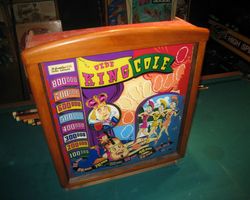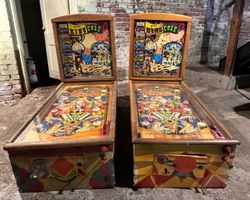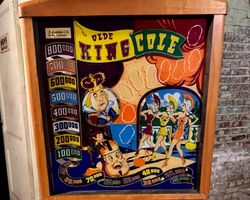Olde King Cole

Average Prices: USD $200 to $1,300
Produced: May, 1948
Production Run: 1,500 units
Machine Type: Electro-mechanical
Players: 1
Design by: Harry Mabs
Art by: Roy Parker
"Olde King Cole" stands as a significant entry in the early evolution of the flipper pinball machine, manufactured by D. Gottlieb & Co. and released in May 1948. This electro-mechanical (EM) game, produced in a run of 1,500 units, holds a place as the fifth Gottlieb title to incorporate the then-nascent flipper technology, a feature that would fundamentally redefine pinball gameplay. The machine's design and concept were shaped by Harry Mabs, with the whimsical and engaging artwork brought to life by Roy Parker. Mabs's vision for "Olde King Cole" drew directly from the classic nursery rhyme, infusing the game with a narrative charm. Interestingly, the historical roots of the "Olde King Cole" poem are said to trace back to King Coel Hen of Siluria, a British monarch from 125 A.D., adding a layer of historical intrigue to its whimsical theme. Gottlieb's strategic integration of flippers at this nascent stage positioned "Olde King Cole" as an early testament to the company's commitment to innovation, shaping the nascent market for interactive pinball experiences.
Signature Features and Design
"Olde King Cole" defines itself through a design philosophy rooted in the core mechanics of early EM pinball, notably its use of six flippers. Unlike later machines that might feature fewer, more strategically placed flippers, "Olde King Cole" distributed these six across the playfield, demanding a different style of engagement from the player. Complementing the flippers are ten passive bumpers and two kick-out holes, elements crucial to the machine's scoring and ball movement. The absence of modern features such as ramps, drop targets, spinners, or multiball mechanics is not a limitation but rather a characteristic that emphasizes the game’s focus on fundamental pinball skills: precision flipper work, strategic nudging, and ball control. These components work in concert to create an experience where the player’s interaction with the ball, rather than complex rule sets, dictates success. The vibrant artwork by Roy Parker, depicting scenes and characters from the "Olde King Cole" nursery rhyme, adorns the playfield and backglass, imbuing the machine with a playful aesthetic consistent with its era. The backglass, illuminated by internal lights, serves not just as a visual centerpiece but also as a display for scoring and game state, a standard for EM titles of the period.
Playfield and Mechanics
The playfield of "Olde King Cole" presents a distinct layout that reflects its mid-20th century design philosophy. The six flippers are a standout feature, positioned to create various shot opportunities and challenge players to adapt their technique. Two flippers are conventionally placed at the bottom of the playfield, guarding the drain. The remaining four are strategically distributed higher up, often in pairs or along the sides, allowing for unique ricochet shots and the ability to propel the ball back into the upper playfield. Ten passive bumpers are scattered across the playfield, acting as primary scoring elements. When struck by the ball, these bumpers register points and impart unpredictable rebounds, adding an element of chance and requiring quick reflexes. Two kick-out holes are integrated into the layout, typically rewarding significant points or triggering specific game states when the ball lands within them. These holes often require precise aim or a favorable bounce for activation.
The playfield’s artwork by Roy Parker is a visual extension of the "Olde King Cole" theme. Figures of the merry monarch, his fiddlers three, and other whimsical elements from the nursery rhyme are rendered in a charming, illustrative style common to Gottlieb machines of the time. The color palette is bright and inviting, creating a visually stimulating environment that draws players into the machine's narrative. The design philosophy behind "Olde King Cole" centers on a more open playfield, emphasizing ball flow through bumper deflections and targeted shots into kick-out holes, rather than complex pathways or ramp combinations. Success often stems from controlling the ball's momentum and using the flippers to guide it through scoring zones defined by the arrangement of bumpers and holes. The simple yet effective lighting, primarily through backglass illumination, ensures visibility and enhances the playful aesthetic, contributing to the overall player immersion characteristic of early EM games.
Gameplay Dynamics
The gameplay dynamics of "Olde King Cole" distinguish it from later pinball machines, demanding a unique approach to achieve high scores and replays. Lacking multiball, spinning discs, or complex progressive modes, the game focuses intensely on single-ball play and fundamental ball control. The scoring system is straightforward, primarily rewarding contact with the numerous passive bumpers and successful shots into the two kick-out holes. Mastering "Olde King Cole" involves understanding the subtle interactions between the ball, the six flippers, and the ten passive bumpers. The early flipper technology means that precise, controlled flips are paramount, often more effective than powerful, indiscriminate shots.
A defining characteristic of "Olde King Cole" gameplay, as noted by enthusiasts, is its initial difficulty and learning curve. Players accustomed to modern machines might find it challenging or even slow at first. However, a patient and adaptive strategy unlocks its depth. Rather than a relentless "active" approach of constantly hitting the ball, a more "passive" technique often proves effective. This involves a delicate touch with the flippers, sometimes holding the ball to control its momentum, or executing short, controlled flips to guide it towards specific scoring opportunities rather than simply keeping it in play. Learning to "lose the ball gracefully" to earn points or replays highlights a strategic element where allowing a controlled drain from a high-scoring area might be more beneficial than a frantic attempt to save a low-value ball. This nuanced interaction between player and machine cultivates an addictive quality, rewarding persistence and the development of a unique rhythmic play style. The objective is clear: maximize points by skillfully navigating the ball through the playfield, making every flip and nudge count towards the ultimate goal of a high score or a coveted replay.
Reception and Legacy
"Olde King Cole" holds a distinct place in pinball history, particularly within the community that appreciates early electro-mechanical machines. Its reception is often characterized by a dichotomy: while some players might initially find its gameplay challenging or even unengaging compared to the complexity of later titles, those who invest the time to understand its unique mechanics often laud it as a rewarding experience. A common sentiment among its admirers is that "Olde King Cole" is a "keeper," a machine that, once mastered, offers deep satisfaction. Its strengths lie in its foundational gameplay, which demands patience and a refined touch rather than brute force. The six flippers, an unusual configuration for its time and unique to its era, present a different kind of skill test, rewarding players who learn to control the ball's unpredictable bounces off the numerous passive bumpers and guide it precisely into the kick-out holes.
The primary criticisms often revolve around its steep learning curve and perceived initial difficulty. Players accustomed to the intricate rules and rapid-fire action of modern pinball might find "Olde King Cole" slow or unforgiving at first. However, this very challenge contributes to its legacy. It serves as a historical touchstone, representing a crucial phase in pinball's evolution as flipper technology became standard. As one of Gottlieb's earliest flipper games, it illustrates the nascent design principles before the widespread adoption of ramps, drop targets, and multi-ball play. "Olde King Cole" is also recognized as part of Gottlieb's "fairy tale series," contributing to a lineage of themed machines. Its significance lies in demonstrating how basic flipper mechanics, combined with strategic playfield layouts, could create engaging and enduring experiences. It stands as a testament to an era where fundamental interaction, rather than elaborate features, defined the pinball experience, influencing the understanding and appreciation of subsequent EM designs.
Sponsored Links
 Ebay Listings
Ebay Listings
 Auction Results
Auction Results
| Cost | Location | Date |
|---|---|---|
| USD $1,100 |  Ohio, United States Ohio, United States |
12 September, 2024 |
| USD $250 |  Ohio, United States Ohio, United States |
12 September, 2024 |
| USD $1,600 |  North Dakota, United States North Dakota, United States |
11 February, 2020 |
| USD $500 |  Maryland, United States Maryland, United States |
09 June, 2013 |
| USD $183 |  Wisconsin, United States Wisconsin, United States |
30 September, 2007 |


Private Policy · Search Website · Contact Us
As an eBay Partner, we may earn a commission from qualifying purchases made through links on this site, at no additional cost to you.
All trademarks and copyrighted materials remain property of their respective owners. All other content copyright 2007 - 2025 Pinpedia.



